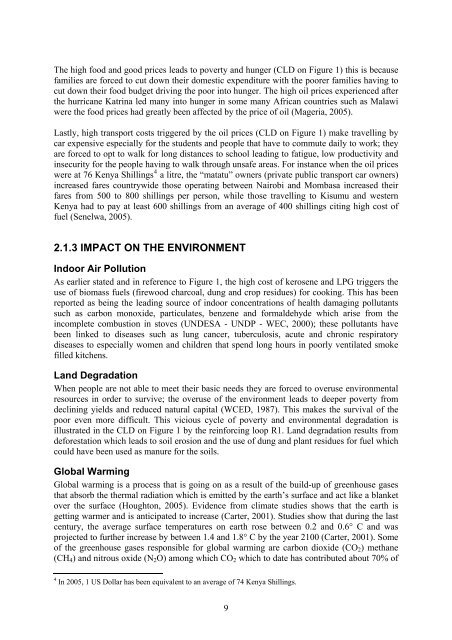ethanol fuel production and use in kenya for sustainable ... - lumes
ethanol fuel production and use in kenya for sustainable ... - lumes
ethanol fuel production and use in kenya for sustainable ... - lumes
You also want an ePaper? Increase the reach of your titles
YUMPU automatically turns print PDFs into web optimized ePapers that Google loves.
The high food <strong>and</strong> good prices leads to poverty <strong>and</strong> hunger (CLD on Figure 1) this is beca<strong>use</strong>families are <strong>for</strong>ced to cut down their domestic expenditure with the poorer families hav<strong>in</strong>g tocut down their food budget driv<strong>in</strong>g the poor <strong>in</strong>to hunger. The high oil prices experienced afterthe hurricane Katr<strong>in</strong>a led many <strong>in</strong>to hunger <strong>in</strong> some many African countries such as Malawiwere the food prices had greatly been affected by the price of oil (Mageria, 2005).Lastly, high transport costs triggered by the oil prices (CLD on Figure 1) make travell<strong>in</strong>g bycar expensive especially <strong>for</strong> the students <strong>and</strong> people that have to commute daily to work; theyare <strong>for</strong>ced to opt to walk <strong>for</strong> long distances to school lead<strong>in</strong>g to fatigue, low productivity <strong>and</strong><strong>in</strong>security <strong>for</strong> the people hav<strong>in</strong>g to walk through unsafe areas. For <strong>in</strong>stance when the oil priceswere at 76 Kenya Shill<strong>in</strong>gs 4 a litre, the “matatu” owners (private public transport car owners)<strong>in</strong>creased fares countrywide those operat<strong>in</strong>g between Nairobi <strong>and</strong> Mombasa <strong>in</strong>creased theirfares from 500 to 800 shill<strong>in</strong>gs per person, while those travell<strong>in</strong>g to Kisumu <strong>and</strong> westernKenya had to pay at least 600 shill<strong>in</strong>gs from an average of 400 shill<strong>in</strong>gs cit<strong>in</strong>g high cost of<strong>fuel</strong> (Senelwa, 2005).2.1.3 IMPACT ON THE ENVIRONMENTIndoor Air PollutionAs earlier stated <strong>and</strong> <strong>in</strong> reference to Figure 1, the high cost of kerosene <strong>and</strong> LPG triggers the<strong>use</strong> of biomass <strong>fuel</strong>s (firewood charcoal, dung <strong>and</strong> crop residues) <strong>for</strong> cook<strong>in</strong>g. This has beenreported as be<strong>in</strong>g the lead<strong>in</strong>g source of <strong>in</strong>door concentrations of health damag<strong>in</strong>g pollutantssuch as carbon monoxide, particulates, benzene <strong>and</strong> <strong>for</strong>maldehyde which arise from the<strong>in</strong>complete combustion <strong>in</strong> stoves (UNDESA - UNDP - WEC, 2000); these pollutants havebeen l<strong>in</strong>ked to diseases such as lung cancer, tuberculosis, acute <strong>and</strong> chronic respiratorydiseases to especially women <strong>and</strong> children that spend long hours <strong>in</strong> poorly ventilated smokefilled kitchens.L<strong>and</strong> DegradationWhen people are not able to meet their basic needs they are <strong>for</strong>ced to over<strong>use</strong> environmentalresources <strong>in</strong> order to survive; the over<strong>use</strong> of the environment leads to deeper poverty fromdecl<strong>in</strong><strong>in</strong>g yields <strong>and</strong> reduced natural capital (WCED, 1987). This makes the survival of thepoor even more difficult. This vicious cycle of poverty <strong>and</strong> environmental degradation isillustrated <strong>in</strong> the CLD on Figure 1 by the re<strong>in</strong><strong>for</strong>c<strong>in</strong>g loop R1. L<strong>and</strong> degradation results fromde<strong>for</strong>estation which leads to soil erosion <strong>and</strong> the <strong>use</strong> of dung <strong>and</strong> plant residues <strong>for</strong> <strong>fuel</strong> whichcould have been <strong>use</strong>d as manure <strong>for</strong> the soils.Global Warm<strong>in</strong>gGlobal warm<strong>in</strong>g is a process that is go<strong>in</strong>g on as a result of the build-up of greenho<strong>use</strong> gasesthat absorb the thermal radiation which is emitted by the earth’s surface <strong>and</strong> act like a blanketover the surface (Houghton, 2005). Evidence from climate studies shows that the earth isgett<strong>in</strong>g warmer <strong>and</strong> is anticipated to <strong>in</strong>crease (Carter, 2001). Studies show that dur<strong>in</strong>g the lastcentury, the average surface temperatures on earth rose between 0.2 <strong>and</strong> 0.6° C <strong>and</strong> wasprojected to further <strong>in</strong>crease by between 1.4 <strong>and</strong> 1.8° C by the year 2100 (Carter, 2001). Someof the greenho<strong>use</strong> gases responsible <strong>for</strong> global warm<strong>in</strong>g are carbon dioxide (CO 2 ) methane(CH 4 ) <strong>and</strong> nitrous oxide (N 2 O) among which CO 2 which to date has contributed about 70% of4 In 2005, 1 US Dollar has been equivalent to an average of 74 Kenya Shill<strong>in</strong>gs.9
















